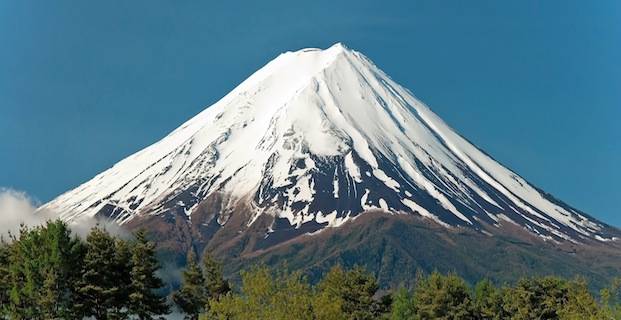Stratovolcano
Stratovolcanoes, or composite volcanoes, are similar to cinder cone
volcanoes in terms of their shape, but that is one of their few
similarities. These volcanoes have gentle lower slopes but much steeper
upper slopes, creating an upwardly concave cone and generally have many
distinct vents. The summit crater of these volcanoes is usually
relatively small.
Despite their general shape, there are some variations within
stratovolcanoes due to various composition and types of eruptions. For
example some of these volcanoes may have features such as calderas or
amphitheaters due to past lateral blasts, such as you can see with Mount
St. Helens.
These volcanoes generally take between tens of thousands and several
hundred thousand years to form. Most of the stratovolcanoes in the world
that are currently active are less than 100,000 years old but some are
much older, possibly over a million, such as Mount Rainier.
Eruptions
Stratovolcanoes are one of the most deadly types of volcanoes and
their most common type of eruption is Plinian, which is highly explosive
and dangerous. These eruptions will generally produce pyroclastic flows
containing toxic gases and hot volcanic fragments that move at very
fast speeds. Stratovolcanoes can erupt any variety of magma types with
levels of basalt, andesite, dacite or rhyolite, but most of the time the
lava cools and then hardens before it spreads very far, meaning that
they will generally have a narrower base than other types, such as
shield volcanoes. Unlike several other types of volcanoes, a
stratovolcano usually has a large rest between eruptions.
Chilean Andes
Nevado Ojos del Salado is the highest volcano on earth. This Chilean
stratovolcano rises to 6,887 meters above sea level. Close to it, also
in the Chilean Andes, is Llullaillaco which is the tallest volcano to
have eruptions in recorded history, measuring 6,739 meters. Nevado Ojos
del Salado has a crater lake at around 6,390 meters above sea level,
which is one of the highest lakes in the world, if not the highest.
Scientists believe that the most recent eruption took place about 1,300
years ago, but are not positive. There is a possibility that the volcano
emitted a small bit of ash in 1993 which would make it historically
active and the tallest historically active volcano instead of
Llullaillaco.
Llullaillaco is actually right on Chile’s border with Argentina. This
stratovolcano is made up of a younger volcano that developed on top of
an older one whose upper area collapsed around 150,000 years ago. The
younger volcano began developing around 10,000 years ago.
Mount St. Helens
Although Mount St. Helens has the title of one of the youngest
stratovolcanoes located in the Cascades, it is the most active. Just
within the last 3,500 years, at least 35 layers of tephra have been
created by its eruptions. This stratovolcano is most well-known for its
eruption in 1980 which killed 57 people in addition to destroying 185
miles of highway, 15 miles of railways, 47 bridges and 250 homes. This
eruption was triggered by a 5.1 earthquake and created an avalanche of
debris that had a volume of around 0.7 cubic miles.
Mount Rainier
Mount Rainier is the tallest peak of the Cascade Range and measures
in at an elevation of 4,392 meters. Although Mount Rainier itself has
developed within the last half a million years, between one and two
million years ago there was a similar cone in its place. An eruption
that took place 5,600 years ago created a large crater at its top but
this was later filled when the summit was rebuilt by later eruptions.
Although the most recent magmatic eruption of this stratovolcano took
place around 1,000 years ago, it has had several dozen highly explosive
eruptions since the previous ice age which have spread tephra all across
the state of Washington.
Krakatoa
Krakatoa is a volcanic island located that is part of the Sunda
Strait. In 1883 this stratovolcano had a series of violent eruptions
which sent ash flying more than 50 miles into the atmosphere in addition
to being heard at least 2,200 miles away from its location. The large
release of energy from its eruption caused tsunamis which in turn took
the lives of 36,400 people on Sumatra and Java.
Tambora
Tambora is an Indonesian stratovolcano that erupted in 1815. In fact,
these eruptions were so violently explosive that they are one of the
largest in the entirety of recorded history. When the volcano erupted,
the global temperatures dropped around three degrees Celsius, which is
no surprise as ash was ejected 50 kilometers into the atmosphere.
Because the stratovolcano erupted so much material, it caved in after
the eruption was complete and in the process created a caldera that is
large enough to be visible from space.

No comments:
Post a Comment